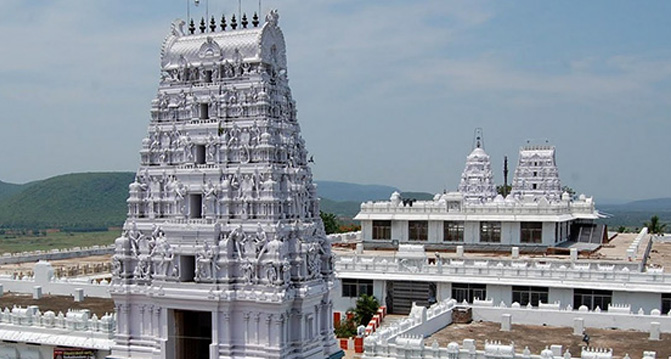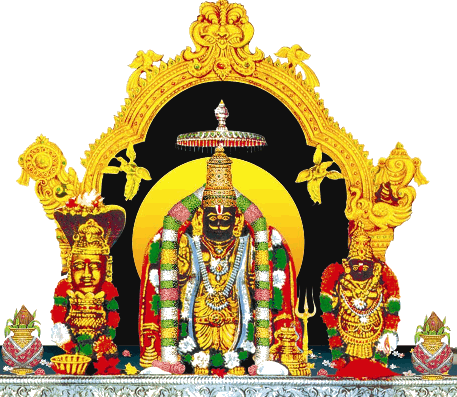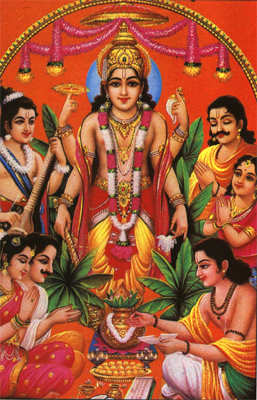 Annavaram is one of the most famous Holy Shrines in India and enjoying second place after Tirupati in Andhra Pradesh. The temple is built in the Dravidian style. The glory and richness of Lord SATYADEVA was widely
Annavaram is one of the most famous Holy Shrines in India and enjoying second place after Tirupati in Andhra Pradesh. The temple is built in the Dravidian style. The glory and richness of Lord SATYADEVA was widely
Anna translates to "what you desire", while "varam" means boon or godsend. Hence, the name Annavaram is an expression of the belief that the deity will endow one with whatever one desires described in Revakhanda of Skandapuranam. The presiding deity Lord Satyadeva with his consort Sri Anantha Lakshmi on one Side and with Lord Siva on the other side took his abode on Ratnagiri, which is named after Ratnakara, son of Meru the king of holy mountains. Like in all Divyakshetrams as surrounded and followed by holy rivers, Sri Satyanarayana Swamy at Annavaram is also followed by sacred Pampa River touching the feet of the hill. Lord Satyadeva the god of truth is showering his eternal blessings on mankind in his beautiful manifested form of the DIVINE TRINITY namely Hari Hara Hiranya Garbha Thrimurtyatmaka. Hence this is the temple that is attracting the Pilgrims of both Vishanava and Saiva devotees and thousands of pilgrims from all over the Country are worshiping Lord Satyadeva every day forgetting all sectional differences.
Enriched by the installation of SRIMATHRIPATHVIBHUTI VYKHUNTA MAHA NARAYANA YANTRA, which plays a dominant and important role with the power of attraction of both money and men (Dhana Janakarsha). The Peetham of Swamyvaru is highly adorned with the installation of Panchayatana, befitting the glory and sanctity of the deity.
This famous yantra is a unique one, the like of which does not exist any where else in India.
Sthala Puranam
It is believed that the place was known for constant food distribution (free feeding) by the benevolent people of the locality and that therefore the place was called by the name Annavaram(annam means food in Telugu). Another version is that because the presiding deity of the place blesses the devotees with anina varam (pronounced or wanted boon), the place is called Annavaram.
 The hillock by the side of the village is considered to be very sacred. Meruvu, the lord of the hills and his consort Menaka did great penance and begot two sons by the grace of Lord Vishnu. One was named Bhadra and the other Ratnakar. Bhadra pleased Lord Vishnu with his devotion and penance and with his grace became Bhadrachalam on which Lord Sri Rama had permanently settled. Ratnakara desired to emulate his brother and succeeded in pleasing Lord Vishnu by his penance to settle on him as Veera Venkata Satyanarayanaswamy, Ratnakara remaining as Ratnagiri (hill). Ratnagiri Hill ranges are said to be connected with two strategic incidents. Tradition says that Sri Krishadevaraya of Vijayanagar used the secret underground passages in the hills to attack the enemy from both sides during his invasion on kalinga kings. The Andhra revolutionary late Alluri Seetharama Raju had some of the secret quarters for himself and his followers in these hill ranges, when he rebelled against the British Rule.
The hillock by the side of the village is considered to be very sacred. Meruvu, the lord of the hills and his consort Menaka did great penance and begot two sons by the grace of Lord Vishnu. One was named Bhadra and the other Ratnakar. Bhadra pleased Lord Vishnu with his devotion and penance and with his grace became Bhadrachalam on which Lord Sri Rama had permanently settled. Ratnakara desired to emulate his brother and succeeded in pleasing Lord Vishnu by his penance to settle on him as Veera Venkata Satyanarayanaswamy, Ratnakara remaining as Ratnagiri (hill). Ratnagiri Hill ranges are said to be connected with two strategic incidents. Tradition says that Sri Krishadevaraya of Vijayanagar used the secret underground passages in the hills to attack the enemy from both sides during his invasion on kalinga kings. The Andhra revolutionary late Alluri Seetharama Raju had some of the secret quarters for himself and his followers in these hill ranges, when he rebelled against the British Rule.
The temple of Sri Veera Venkata Satyanarayanaswamy is the main temple on the Ratnagiri hill. There are also a temple of Sri Rama and the shrines of Vana Durga and Kanaka Durga nearby. The temple of gramadevatha"Nerellamma" (village deity) is in the village at the foot of the hill.
It is said that one Brahmin of the village by name Earanki prakasam got a dream wherein lord appeared and told him that his vigraha was left abondened on the hill without worship and they shall trace it and reconsecrate it. That Brahmin informed the said fact to Sri Raja I.V.Ramarayanam,the then Zamindar of Gorasa of kirlampudi estate, and both of them along with other villagers traced the idol on the hill, worshipped it and installed it. at the present spot on Sravana Suddha Vidiya of the Telugu year Khara (i.e.) 1891 A.D (Fasli 1301).
The main temple was constructed on the hill with the pleasing and distant view of Bay Of Bengal (11 miles) on one side and the row of Eastern Ghats on the other side the green fields alround the hills and the pampa River encircling Ratnagiri.The hillock itself is about 300 feet above the sea level.About 300 well - laid stone steps lead to the top of it.
Initially a small shed was constructed in 1891 when the idol was found. Later a temple was built in course of time with the cooperation of villagers and other devotees of the near by villages. Subsequently the temple was reconstructed during 1933-34, with locally available stone. Later when the same reached dilapiated condition, it was reconstructed during 2011-2012.
The main temple is constructed in the form of a chariot with the four wheels at each of the four corners. In front of the main temple is the kalyana mantapa, constructed and decorated with modern pieces of architecture. As we go down the way,we come across Ramalaya and then the shrines of Vana Durga is held in great veneration and Devi is said to be seen even to this day in the nights, going about the holy precincts perpetually guarding the Lord's premises.
The Akriti of any temple is, according to the Agni Purana, merely a manifestation of the Prakriti. This idea is further developed in the ancient texts, and the entire Slipa Sastra is based on the principle that the wall and the vimana of the temple should be so constructed as to remind a devotee, of the universe, and the Lord inside representing the Supreme Spirit which is the core and being of the entire Universe. According to these tests, the chariot is intended as a symbol of the seven lokas underneath, and the seven lokas above, with the garbhalaya of the Lord, at the heart center ruling over the entire universe. The temple at Annavaram has been constructed to depict this idea concretely. The front side of the temple depicts the chariot. The Meru on the floor with the pillar at the center, and the idols at the top are intended to bring forth the idea that the Lord not only remains at the heart's center but also permeates the entire universe. The wheels depicting the Sun and the Moon serve to remind us that this Jaggernaut moves on the wheels of time, and goes on forever and ever. Thus the Annavaram temple satisfies both the ritualistic values and the spiritual aspirations of its devotees.
The idol is about 13 feet high in a cylindrical form, the base being in the lower sanctum representing Lord Brahma and the top is in the upper sanctum representing Lord Vishnu. The middle portion represents Lord Siva. There are some temples representing the unity of Lords Hari and Hara in some places and this is the place where even Brahma who is generally denied temple worship, is clubbed with the other two, and the creator (Brahma), the protector (Vishnu) and destroyer (Siva) are worshipped simultaneously. The image of the lord forming a single idol representing the Trimurthis-Brahma, Vishnu and Siva is of unique attraction.
Moolatho Brahma roopaya Madhayathashca Maheswaram
Agrathah Vishnuroopaya Traika roopayathenamaha
The temple is in two floors; the ground floor contains the yantra and the peetham of the Lord. On the four sides of the yantra there are four deities namely Ganapati, Suryanarayanaswamy, Bala Tripurasundari and Maheswaraswamy which constitutes panchayathanam. In the 1st floor the Moola virat of Lord Satyanarayana swamy is in the centre, the image of Goddess Anantha Lakshmi Ammavaru is in the right and Lord Shiva is on the left. The idols are of exquisite grace and beauty and are encaged in gold kavachams.". The adjoining shrine of Sri Rama seems to be the holy spot where the original self-mainfested idol of Sri Satyanarayanaswamy was discovered by the devotees. Lord Sri Rama is considered to be the Kshetra Palaka of this holy abode of the Lord Satyadeva.
Satya Deva Vratha katha 
Hindus perform Sri Satyanarayana Vratham throughout India for weath, education, prosperity, off spring, relief from troubles and sickness and success in business. When it came to be known that Lord Satyanarayana had manifested Himself on the Ratnagiri hills at Annavaram in unique form combining the Trimurthis viz., Brahma, Vishnu and Siva the number of pilgrims from far and near swelled to hundreds and thousands. The average attendance daily is about five thousand now a-days. Though Ekadasi is considered to be very auspicious for the vratham, the individual devotees perform it even on other convenient days. The great popularity behind the vratham springs from the experiences narrated in stories and legends and also the faith gained by observances in daily life.
The important legend connected with this vratham was that once Sage Narada was very much distressed at the misery of marthyas(men in this world) and prayed Lord Vishnu to be informed of a way out for them. The lord then told him that Satyanarayana Vratham would relieve men of their troubles and would ensure worldly prosperity and salvation after death. He also narrated that a pious Brahmin of Banaras performed the vratham first. It was also described how king Ulkamukha of Bhadrasilanagaram, Emperor Tungadhwaja, and a community of Gollas in his kingdom, a Vaisya business man named Sadhuvu, and a poor woodcutter of Banaras has performed this vratham and were blessed by Lord Satyanarayanaswamy (Vishnu himself) with all they desired. The vratham has caught the fascination of millions owing to these stories within the understanding of scholars as well as laymen. All classes of people took to its performance and it is popular for its efficacy.
The origin of the vratham was narrated ad follows: once a highly educated and pious Brahmin who had no means of livelihood was wandering about from place to place being for food. Lord Vishnu had taken pity on his penury and appeared before him in the disguise of a Brahmin and advised him to perform the vratham of Lord Satyanarayanaswamy who is the incarnation of Lord Vishnu. He also told him the way in which the vratham was to be performed. The Brahmin thereupon got up early in the next morning and went out for alms. He could get funds enough for celebrating the vratham and did it as per the vratha directions given by Lord Vishnu. Consequenty, he was blessed by the Lord with prosperity and lived very happily with his family and attained salvation after death. A poor man who has been earning livelihood selling firewood from the forestschanced to go to that Brahmin's house for water to quench his thirst, while the Brahmin was engaged in performing Satyanarayana swamy Vratham. He waited till the end, quenched his thirst and enquired as to what the vratham was. The Brahmin told him in detail all about it and the poor man had decided to perform the vratham himelf and to spend the next day's earnings for the vratham. What he got the next day was enough for the vratham, which he performed with great devotion and became prosperous, happy and attained moksham.
Another legend connected with Satyanarayana Vratham mentioned in Skandapuranam was as follows: A rich Vaisya couple Sadhuvu and Leelavathi begot a dauther Kalavathi as a result of the vow taken to perform Satyanarayana Vratham. They got her married with great pomp to a worthy young man. Sadhuvu and his son-in-law flourished in business and amassed great wealth by the grace of Lord Satyanarayanaswamy. But they forgot to perform Satyanarayana Vratham. They went to Ratnasanapuram on the seashore and commenced business there to add to their wealth. But they had lost the grace of the Lord, as they did not keep up their vow of performing vratham, amidst their prosperity. One night the treasury of the local king had been looted. Sadhuvu and his son-in-law were imprisoned on suspicion, even though they were really innocent. The mother and daughter became poor and sick and were forced to beg for food from house to house. While begging for food kalavathi chanced to witness Satyanarayana Vratham in a Brahmin's house and waited they're to receive the Lord's prasadam. She explained to her mother this incident as the reason for her being late in returning home. Leelavathi then remembered about the vratham and decided to perform it with no loss of time. By the Lord's grace she got all facilities to perform it.
 The lord was pleased as a result of the vratham. Sadhuvu and his son-in-law were released from prison and all their confiscated wealth was returned to them by the king at the command of the Lord in a vision. They prayed to the Lord, performed the vratham, gave large amounts in charity and started back to their original place in a boat. Satyanarayanaswamy appeared in the ship as a sanyasi and asked Sadhuvu what he had on borad. Sadhuvu retorted that it was no concern of the sanyasi to know what in the boat was and ridiculed him by saying that there was some trash. 'Be it so', pronounced the Lord and all the wealth in the boat wsas reduced to trash. Sadhuvu began to weep and wail and as advised by his son-in-law he fell on the feet of the sanyasi and prayed for his pardon. The sanyasi reminded him that he had once again failed to perform His puja. Realising who the sanyasi was, Sadhuvu prayved Him), got back his wealth and safely reached the shores. He sent word to this wife and daughter that they were arriving soon at the house. Leelavathi was happy to receive the news and hastened her daughter to finish Satyanarayana puja so that they could hurry up to the seashore to receive their husbands. In the hurry up to the seashore to receive their husbands. In the hurry both of them forgot to take the prasadam of Satyanarayanaswamy. The consequence was that the boat with the cargo and the son-in-law drowned in the sea. Sadhuvu was much grieved to see his only daughter preparing for sahagamana. He soon realized that Lord Satyanarayana alone could come to his relief and fervently prayed to him.
The lord was pleased as a result of the vratham. Sadhuvu and his son-in-law were released from prison and all their confiscated wealth was returned to them by the king at the command of the Lord in a vision. They prayed to the Lord, performed the vratham, gave large amounts in charity and started back to their original place in a boat. Satyanarayanaswamy appeared in the ship as a sanyasi and asked Sadhuvu what he had on borad. Sadhuvu retorted that it was no concern of the sanyasi to know what in the boat was and ridiculed him by saying that there was some trash. 'Be it so', pronounced the Lord and all the wealth in the boat wsas reduced to trash. Sadhuvu began to weep and wail and as advised by his son-in-law he fell on the feet of the sanyasi and prayed for his pardon. The sanyasi reminded him that he had once again failed to perform His puja. Realising who the sanyasi was, Sadhuvu prayved Him), got back his wealth and safely reached the shores. He sent word to this wife and daughter that they were arriving soon at the house. Leelavathi was happy to receive the news and hastened her daughter to finish Satyanarayana puja so that they could hurry up to the seashore to receive their husbands. In the hurry up to the seashore to receive their husbands. In the hurry both of them forgot to take the prasadam of Satyanarayanaswamy. The consequence was that the boat with the cargo and the son-in-law drowned in the sea. Sadhuvu was much grieved to see his only daughter preparing for sahagamana. He soon realized that Lord Satyanarayana alone could come to his relief and fervently prayed to him.
The Lord revealed that the catastrophe was the result of Kalavathi not taking His prasadam in her hurry to go to her husband. Kalavathi rushed home, took the prasadam and hurried back to the seashore. There she saw her husband Ratnakara safe on the shore. She told him all about the Lord. He was so much impressed that he prayed to the Lord and with His blessings changed into Ratnagiri hill on which the Lord took His permanent abode. It is believed that river Pampa running by the hill is none other than kalavathi, who melted with ecstasy at the grace of the Lord and her husband's achievement and began to flow as Pampa River.